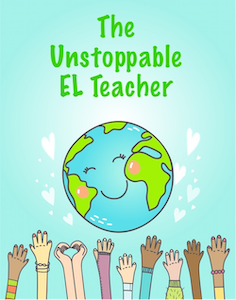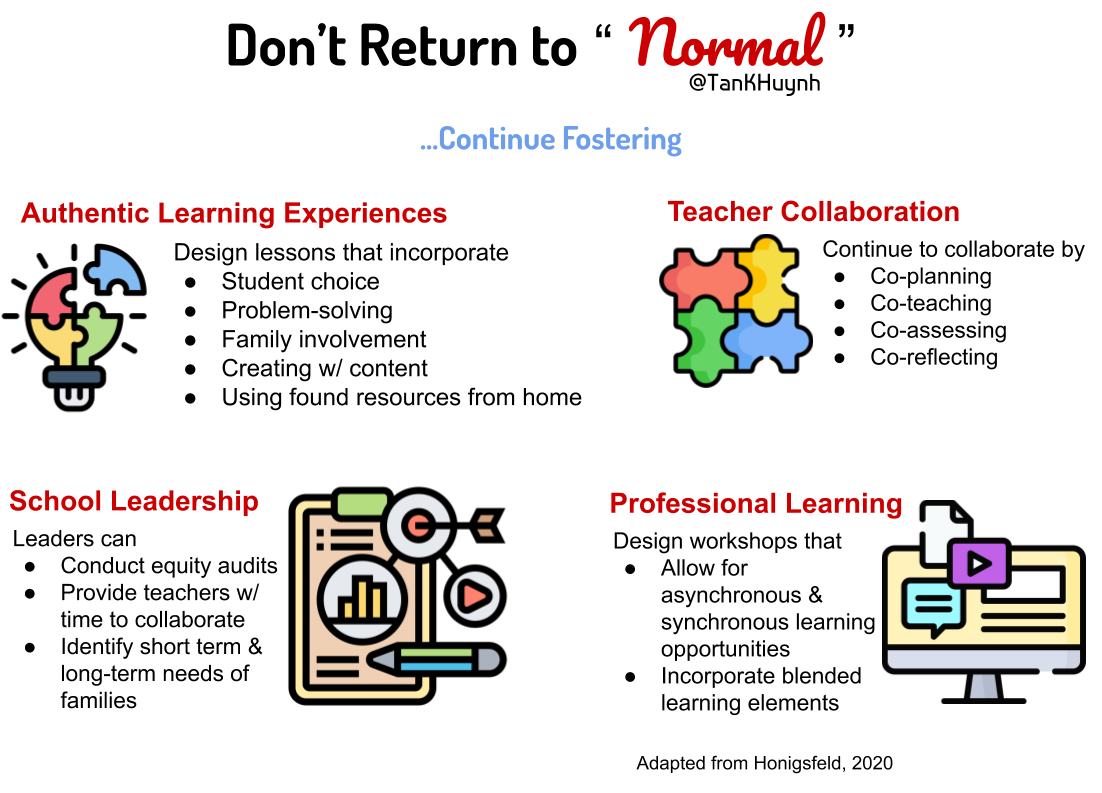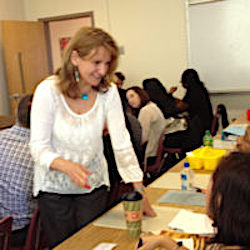Don’t Abandon the New Normal for the Old
A MiddleWeb Blog

I could tell that her passing comment was full of gems to be mined, so I had Andrea return in July to further explore what she meant.
In our most recent podcast conversation, we identified four areas where we can create a new normal using what we have learned from school closures. These areas include:
• Authentic learning experiences
• Teacher collaboration
• School leadership
• Professional learning
A month into the school year in North America, there’s still much to be learned from Andrea’s insights and put to good use as we try to illuminate the path ahead for children, schools and learning.
Authentic Learning Experiences
Andrea shared two examples of authentic learning experiences – both from music classes – that her sons were assigned during the first months of the COVID-19 pandemic.
The elementary school music lesson required students to create their own drums with things they had in the house. Her high school son had to interview a family member about their first musical experience and analyze what relationship they had with music.
These lessons had elements of authentic learning because they:
• allowed for student choice
• facilitated creating with content knowledge
• had students use resources available to them
• provided opportunities for family engagement
• set learning as a problem-solving experience
Since March, school closures have forced us to think outside the box and restructure learning experiences without the resources we have readily available at school. Yet students still have a treasure trove of resources if we think about their families and cultures. As you return to school in whatever model prevails in your community, try to incorporate these elements as you design your lessons.
Andrea shared a tweet from Will Richardson, who talked about having the focus on learning, not schooling. In this time of uncertainty, let’s avoid returning to our classroom with a narrow focus on schooling. Instead, let’s focus on learning.
Teacher Collaboration
Even before COVID-19, Andrea emphasized the role of teacher collaboration as an avenue for raising student achievement, promoting job-embedded professional learning, and increasing skill capacity building (Honigsfeld & Dove, 2019). However, not every school had systems, routines, protocols, and schedules that could support year-long teacher partnerships.
As the virus interrupted traditional brick-and-mortar school structures, most people had to learn new skills to adapt to the circumstances. Some educators were not used to teaching with technology. Some had a few skills, while others were proficient enough to guide their colleagues. Consequently, teacher collaboration became a lifeline rather than a luxury.
During this pandemic, teachers have been seeking each other out to:
• learn new skills
• share and co-design resources
• create systems that support learning
• provide emotional support to deal with uncertainties
• scaffold and differentiate instruction for language learners
• construct the meaning of the constantly changing circumstances
Some teachers have never had the opportunity for teacher collaboration, but with the upheaval of the virus, they formed new teaching relationships that are full of potential.
As you return to your schools in the future, advocate for the time in your schedules for on-going collaboration with your colleagues. Few of us want to remain in isolation after so much time there these past months, so why should we return to teaching in isolated silos?
School Leadership
Principals and district leadership have a significant role in sustaining and expanding some of the unexpected teaching outcomes from this experience. They can:
• create and protect time for teachers to collaborate
• highlight examples of authentic learning
• encourage the integration of families as teaching partners
In addition, Andrea suggests that school and district leadership conduct an equity audit to assess the disparities between communities that have access and those that do not. Then they should categorize these inequities into two groups:
• Short term: Inequities that might be addressed by providing physical resources
• Long term: Inequities that might be addressed at a systems and programmatic level
Lastly, principals and district leadership can capitalize on some of the positive school-parent relationships that were formed during this experience. Andrea asks leaders to consider how we can bring cultural practices and values into schools so that they too can be tools for learning and positively reflect students’ cultures.
Professional Learning
There were so many organizations and consultants who offered virtual professional learning opportunities to support teachers through this experience and to sustain their capacity building despite school closures. As a speaker at various webinars over the past several months, Andrea was no different.
Notably, she recently facilitated a day-long professional learning session that featured a blended teaching model. Instead of a whole day sitting and hearing Andrea talk, she recorded a series of videos that lasted between 20-25 minutes.
Teachers would watch these pre-recorded videos on their own then engage in a series of asynchronous and synchronous learning opportunities on such platforms as Padlet, Answer Garden, Google Slides, and Google Docs.
After that, everyone would gather together on a video conference to ask Andrea questions for the last 25 minutes. The videos, learning opportunities, and video conference would together complete one module. Teachers were then given a short break before the second module started, which also followed the same structure.
The takeaway here is for schools, districts, and consultants to rethink the types of professional learning they are offering. Is an in-person “sit-and-get” the only platform that teachers can have for capacity building? Andrea hopes that districts can leave this pandemic experience with alternative ways to offer asynchronous and synchronous learning opportunities.
Some grief. Some hope!
There is a lot of grief, pain, and isolation from the COVID-19 pandemic on many levels. Yet, there are equally as many learning opportunities that we can carry with us as we return to our classrooms, school buildings, and districts. We all want to get back to normal. Hopefully, it’s a normal that’s even better.
In the comments section, what is one thing that you will do to “not return to normal”?
Honigsfeld, A., Dove, M. G., & Honigsfeld, A. (2019). Collaborating for English learners: a foundational guide to integrated practices. Thousand Oaks, CA: Corwin.


































Hold parent meetings virtually when parents are unable to come to school. Before we would reschedule and/or cancel and sometimes never have the meeting.